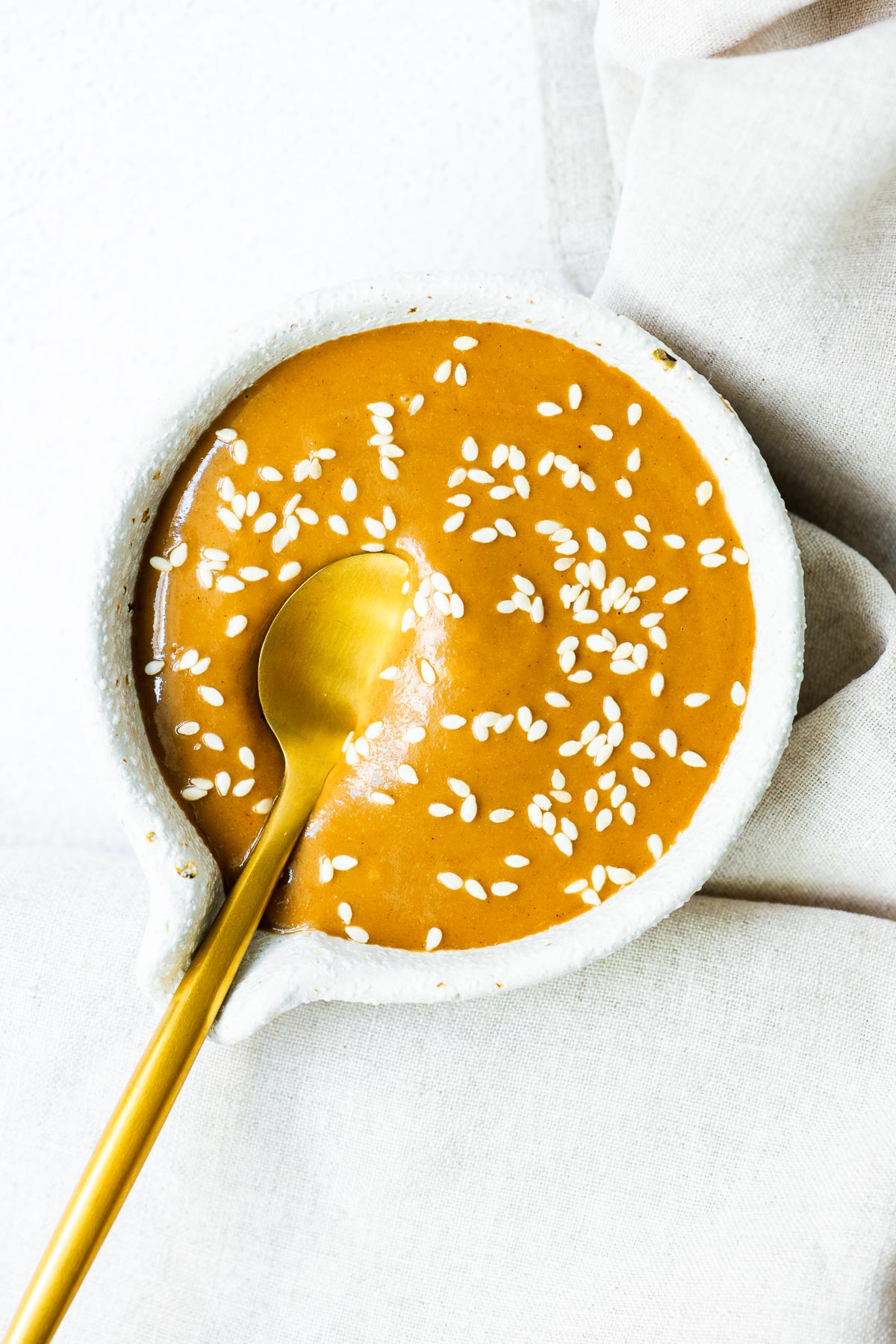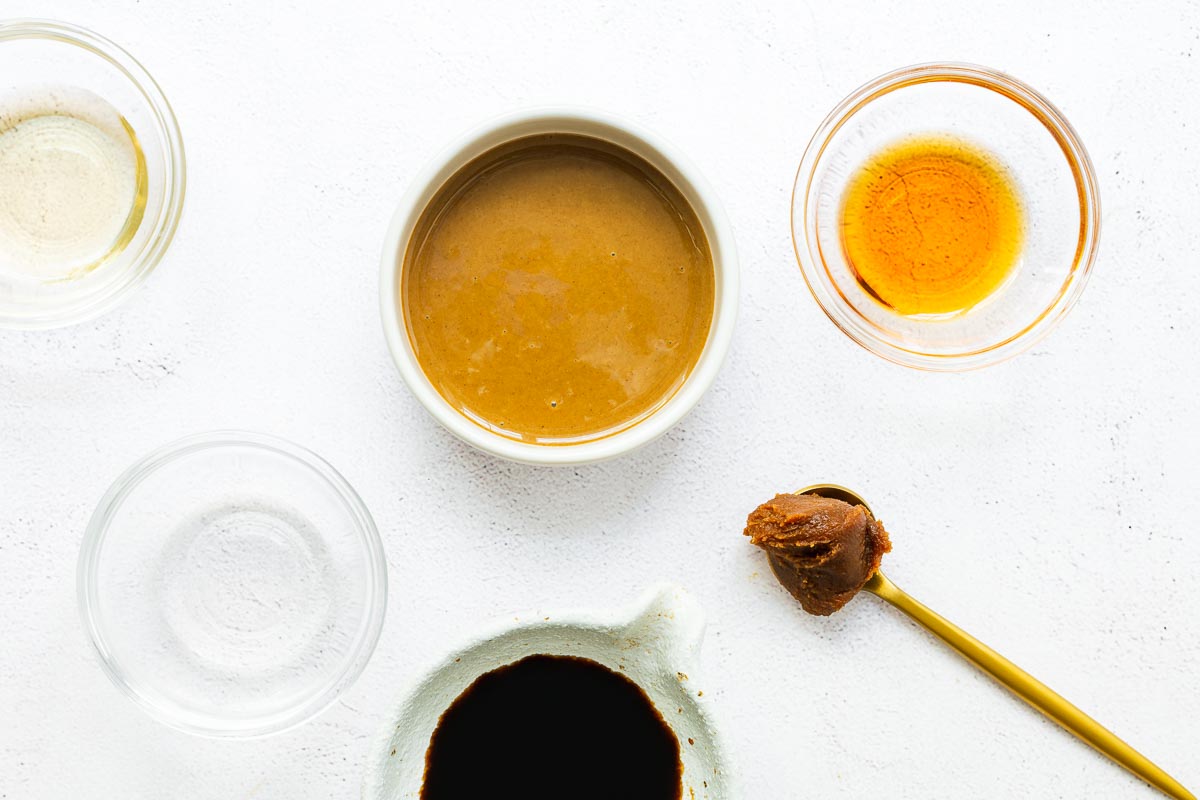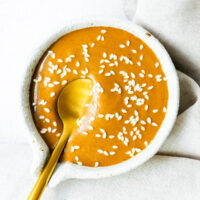Japanese Sesame Sauce (Goma Dare)
This delicious sesame sauce recipe is quick and easy. Get it on the table in less than a minute! Drizzle it over Asian salads, or steamed veggies, serve it as a dipping sauce, or make sesame noodles for a quick weeknight dinner.
Goma dare is a sweet and nutty Japanese dipping sauce. It is delicious and versatile. But best of all, you can have this sesame sauce ready in less than a minute.
Drizzle it over poke bowls, fried rice or steamed veggies, serve it as a dipping sauce, or make the easiest sesame noodles for a quick weeknight dinner.
Keep reading for ingredient notes and serving suggestions, or jump straight to the sesame sauce recipe.

What is goma dare?
In Japanese, goma means sesame and dare sauce. And goma dare is the delicious sesame dipping sauce served with shabu-shabu. This Japanese hot pot dish consists of thinly sliced meat and vegetables boiled in water.
It is common to serve goma dare alongside more condiments, like chopped green onions and ponzu sauce. The citrus soy sauce adds acidity to contrast the creamy dressing.
Neri goma – neri means paste in Japanese – forms the base of the mouthwatering sauce. This unhulled sesame paste is dark brown, creamy and exceptionally nutty. It’s the stuff of dreams for sesame lovers.
Even though tahini is also a sesame paste, Asian sesame paste is closer to unsweetened peanut butter in taste.
Japanese sesame sauce ingredients & substitutes
This delicious goma sauce is simple to make but requires a few ingredients uncommon in a Western pantry. I suggest the best alternatives, but you should be able to find all the ingredients online.
They’re all worth keeping around!
Sesame paste
This paste contains roasted unhulled white sesame seeds that still have their hull (or skin) intact. The seeds are darker brown than the common light-coloured hulled sesame seeds.
As with nut butter, separation may occur in sesame paste. Make sure to stir your paste well to combine any separated oil. I find it easier to decant all the paste into a clean bowl to whisk before returning the homogeneous mixture to the jar.
The roasted sesame hull gives neri goma its dark brown colour and intensely nutty flavour.
Look for the small jars of paste in the Asian aisle of your grocery store. Ask for Chinese sesame paste if you struggle to find it.
Chinese recipes also use black sesame paste. But this has a more intense flavour and will give the sesame sauce a grey colour.
While tahini is technically a sesame paste, it contains crushed, hulled sesame seeds. It has a much paler colour and a milder flavour.
You can use tahini as a Chinese sesame paste alternative. But I found that peanut butter is an even better substitute, especially if you can find unsweetened roasted peanut butter with skins.
Alternatively, you can crush whole sesame seeds into a paste using a food processor or a mortar and pestle. Learn more about how to make tahini (or sesame paste).
Related Post: Sesame paste vs tahini: what’s the difference?
Mirin
Traditional goma dare contains sugar and sake. But sake is not something I use often, and it can be expensive. So, I go for the sweet rice wine called mirin and omit the sugar.
If you have open sake – or plan on serving some with dinner – you can add two tablespoons of sake and one teaspoon of sugar instead of the two tablespoons of mirin.
If you don’t have sake or mirin, replace the two tablespoons of mirin with a tablespoon of white wine vinegar and a teaspoon of brown sugar. And leave out the teaspoon of rice vinegar.
Soy sauce
I use Kikkoman all-purpose soy sauce, but you can also use light soy sauce, low sodium soy sauce or tamari.
If you want to use sweet soy sauce (kecap manis), you need to use sake instead of mirin, or the sesame sauce will be too sweet.
Toasted sesame oil
Toasted sesame oil boosts the nutty flavour of the sesame paste.
But if you don’t have any, you can use a tablespoon of olive oil or a neutral-tasting oil instead.
Miso paste
This funky fermented soybean paste is popular in Japanese recipes. The taste can vary from fruity and sweet to intensely savoury. While Japanese white miso works best for a mild and sweet sauce, you can use any miso paste in this sesame sauce recipe.
If you don’t have miso or need to keep the sesame dressing gluten-free, you can omit the miso completely. Or try a miso paste substitute if you’ve run out.
Taste and adjust the seasoning if you do.

Rice vinegar
This sesame sauce recipe calls for rice vinegar or rice wine vinegar, not seasoned rice vinegar. But, if seasoned rice vinegar is all you have, go ahead. However, the resulting sauce will be sweeter.
You can also use apple cider vinegar or white wine vinegar.
Toasted sesame seeds (optional topping)
To toast hulled sesame seeds, place a small skillet over medium-high heat. Add the sesame seeds in a single layer. And toast them in the dry pan until they are golden brown, stirring now and then.
Or roast sesame seeds in the oven. Make a large batch, it will keep for up to three months!
Transfer the toasted sesame seeds to a small bowl straight away.
You can give them a quick bash in a mortar and pestle and stir through the sesame sauce for some texture, or use them whole as a garnish.
Optional add-ins and variations
- Dashi powder: Add half a teaspoon of dashi powder to the sesame dressing. It adds a funky umami flavour. But it’s not suitable for vegetarians or vegans.
- Garlic: You can grate half a clove of garlic into the sauce if you want a more savoury sauce.
- Fresh ginger: While not traditionally Japanese, half a teaspoon of grated fresh ginger adds a lovely zing to any sesame sauce.
- Chilli powder: Add a teaspoon of chilli powder or red pepper flakes to make a spicy sesame sauce.

How to make Japanese sesame dressing
There are different ways to make goma dare at home. Some methods require bashing sesame seeds with a mortar and pestle (or food processor).
But this version goes for speed and ease of use (without sacrificing flavour). It is also the best sesame sauce recipe if you want to make a small batch. This goma dare recipe makes about half a cup of sesame sauce.
Grab a measuring spoon and scoop three tablespoons of sesame paste, two tablespoons of mirin, one tablespoon of soy sauce, one tablespoon of toasted sesame oil, a teaspoon of miso and a teaspoon of rice vinegar into a small mixing bowl.
Whisk together until well combined.
Serve the sauce at room temperature.

How to use goma dare
While goma dare is best known as a shabu-shabu condiment, it is a wonderfully versatile sauce.
Dipping sauce
Serve it with a traditional Japanese hot pot or with a variety of fresh vegetables like sliced bell peppers, cucumber slices and celery sticks.
Or try dipping spring rolls or rice paper rolls in the creamy sesame sauce.
Steamed vegetables
Goma-ae is a Japanese side dish of cooked green vegetables and sesame sake sauce or miso, topped with sesame seeds. Typical vegetables include spinach and green beans.
Similarly, I love to drizzle the sesame dressing over steamed green vegetables like broccoli. I prefer the hands-off method of steaming broccoli in an instant pot.

Noodle sauce
It should be no surprise that goma dare makes a delicious noodle sauce.
Place cooked soba noodles in a large bowl, add red pepper flakes, grated garlic and sliced green onions. Toss the noodles and aromatics with a generous amount of sesame sauce and serve with more toasted sesame seeds and strips of nori seaweed.
Asian slaw
Use sesame sauce as a healthy alternative to mayonnaise in coleslaw. And sprinkle the Asian slaw with more toasted sesame seeds.
Frequently asked questions
In Japanese, goma means sesame and dare sauce. Goma dare is the delicious sesame dipping sauce served with shabu-shabu.
Asian sesame sauce is a deliciously creamy condiment made from a combination of sesame paste, soy sauce and other seasonings depending on the region. Japanese sesame sauce (goma dare) often includes mirin, miso paste and dashi.
Sesame sauce makes a great dipping sauce, salad dressing or stir-fry sauce. Serve Japanese sesame sauce as a dipping sauce for shabu-shabu, spoon it over steamed broccoli or sauteed spinach, or drizzle it over Asian-style slaw salads.

Equipment
Ingredients
- 3 tablespoons sesame paste, or tahini
- 2 tablespoons mirin
- 1 tablespoon soy sauce
- 1 tablespoon toasted sesame oil
- 1 teaspoon miso
- 1 teaspoon rice vinegar
- 1 teaspoon toasted sesame seeds (optional), for garnish
Instructions
- Place the ingredients in a small bowl and whisk until smooth and creamy.
- Serve it at room temperature as a dipping sauce or stir it through cold noodles for an easy weeknight dinner.
Notes
- Transfer leftover sauce to an airtight container, refrigerate and use within a week.
- See the ingredients and substitutes section for ingredient alternatives.

This was so easy and delicious! I dipped my springrolls in the sauce – wow!
This Japanese sesame sauce is so versatile! I’m so happy you enjoyed making and eating it, Sarah.